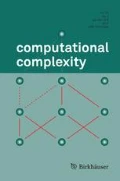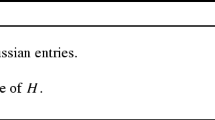Abstract
We consider two known lower bounds on randomized communication complexity: the smooth rectangle bound and the logarithm of the approximate nonnegative rank. Our main result is that they are the same up to a multiplicative constant and a small additive term.
The logarithm of the nonnegative rank is known to be a nearly tight lower bound on the deterministic communication complexity. Our result indicates that proving an analogous result for the randomized case, namely that the log approximate nonnegative rank is a nearly tight bound on randomized communication complexity, would imply the tightness of the information complexity bound.
Another corollary of our result is the existence of a Boolean function with a quasipolynomial gap between its approximate rank and approximate nonnegative rank.
We also show that our method yields an alternative simple proof of the equivalence between the approximate rank and the approximate μ norm, first shown by Lee and Shraibman.
Similar content being viewed by others
References
Noga Alon (2003) Problems and results in extremal combinatorics–I. Discrete Mathematics 273(1-3): 31–53
Noga Alon (2009) Perturbed Identity Matrices Have High Rank: Proof and Applications. Combinatorics, Probability & Computing 18(1-2): 3–15
Sanjeev Arora, Rong Ge, Ravindran Kannan & Ankur Moitra (2012). Computing a nonnegative matrix factorization - provably. In STOC, 145–162.
Ziv Bar-Yossef, T. S. Jayram, Ravi Kumar & D. Sivakumar (2004). An information statistics approach to data stream and communication complexity. Journal of Computer and System Sciences 68(4): 702–732.
LeRoy B. Beasley & Thomas J. Laffey (2009). Real rank versus nonnegative rank. Linear Algebra and its Applications 431(12), 2330 – 2335. ISSN 0024-3795. URL http://www.sciencedirect.com/science/article/pii/S0024379509001256. Special Issue in honor of Shmuel Friedland.
Mark Braverman (2012). Interactive information complexity. In STOC, 505–524.
Mark Braverman & Anup Rao (2011). Information Equals Amor tized Communication. In FOCS, 748–757.
Amit Chakrabarti, Yaoyun Shi, Anthony Wirth & Andrew Chi-Chih Yao (2001). Informational Complexity and the Direct Sum Problem for Simultaneous Message Complexity. In FOCS, 270–278.
Anat Ganor, Gillat Kol & Ran Raz (2015). Exponential Separation of Communication and External Information. Electronic Colloquium on Computational Complexity (ECCC) 22, 88. URL http://eccc.hpi-web.de/report/2015/088.
Dmitry Gavinsky & Shachar Lovett (2013). En Route to the log-rank Conjecture: New Reductions and Equivalent Formulations. Electronic Colloquium on Computational Complexity (ECCC) 20, 80.
Mika Göös, Shachar Lovett, Raghu Meka, Thomas Watson & David Zuckerman (2015). Rectangles Are Nonnegative Juntas. In STOC, 257–266. URL http://doi.acm.org/10.1145/2746539.2746596.
Rahul Jain & Hartmut Klauck (2010). The Partition Bound for Classical Communication Complexity and Query Complexity. In CCC, 247–258.
Iordanis Kerenidis, Sophie Laplante, Virginie Lerays, Jérémie Roland & David Xiao (2012). Lower Bounds on Information Complexity via Zero-Communication Protocols and Applications. In FOCS, 500–509.
Matthias Krause (1996) Geometric Arguments Yield Better Bounds for Threshold Circuits and Distributed Computing. Theoretical Computer Science 156(1&2): 99–117
Eyal Kushilevitz & Noam Nisan (1997). Communication complexity. Cambridge University Press. ISBN 978-0-521-56067-2, I-XIII, 1-189.
Sophie Laplante, Virginie Lerays & Jérémie Roland (2012). Classical and Quantum Partition Bound and Detector Inefficiency. In ICALP (1), 617–628.
Troy Lee (2012). Some open problems around nonnegative rank.
Troy Lee & Adi Shraibman (2009a). An Approximation Algorithm for Approximation Rank. In CCC, 351–357.
Troy Lee, Adi Shraibman (2009b) Lower Bounds in Communication Complexity. Foundations and Trends in Theoretical Computer Science 3(4): 263–398
Nati Linial, Shahar Mendelson, Gideon Schechtman & Adi Shraibman (2007). Complexity measures of sign matrices. Combinatorica 27(4), 439–463. URL https://doi.org/10.1007/s00493-007-2160-5.
Nati Linial & Adi Shraibman (2007). Lower bounds in communication complexity based on factorization norms. In STOC, 699–708.
László Lovász (1990). Communication complexity: A survey. Path, flows, and VLSI-networks 235–265.
László Lovász & Michael E. Saks (1988). Lattices, Möbius functions and communication complexity. In FOCS, 81–90.
Shachar Lovett (2016). Communication is Bounded by Root of Rank. J. ACM 63(1), 1:1–1:9. URL http://doi.acm.org/10.1145/2724704.
Kurt Mehlhorn & Erik Meineche Schmidt (1982). Las Vegas Is better than Determinism in VLSI and Distributed Computing (Extended Abstract). In STOC, 330–337.
Ilan Newman (1991) Private vs. Common Random Bits in Communication Complexity. Information Processing Letters 39(2): 67–71
Noam Nisan, Avi Wigderson (1995) On Rank vs. Communication Complexity. Combinatorica 15(4): 557–565
Alexander A. Razborov (2002). Quantum Communication Complexity of Symmetric Predicates. Izvestiya of the Russian Academy of Science, Mathematics 67, 2003.
Thomas Rothvoss (2014). The matching polytope has exponential extension complexity. In Symposium on Theory of Computing, STOC 2014, New York, NY, USA, May 31 - June 03, 2014, 263–272. URL http://doi.acm.org/10.1145/2591796.2591834.
Stephen A. Vavasis (2009). On the Complexity of Nonnegative Matrix Factorization. SIAM Journal on Optimization 20(3), 1364–1377
Mihalis Yannakakis (1991) Expressing Combinatorial Optimization Problems by Linear Programs. Journal of Computer and System Sciences 43(3): 441–466
Acknowledgements
We thank Noga Alon for bringing Lemma Lemma 3.1 to our attention, and the anonymous reviewers for helpful comments that improved the presentation of this paper.
The research of Shay Moran is supported by the National Science Foundation under agreement No. CCF-1412958 and by the Simons Foundations. The research of Amir Shpilka is supported by the Israel Science Foundation (grant number 552/16) and by Len Blavatnik and the Blavatnik Family foundation. The research of Amir Yehudayoff is supported by ISF Grant No. 1162/15.
Author information
Authors and Affiliations
Corresponding author
Rights and permissions
About this article
Cite this article
Kol, G., Moran, S., Shpilka, A. et al. Approximate Nonnegative Rank is Equivalent to the Smooth Rectangle Bound. comput. complex. 28, 1–25 (2019). https://doi.org/10.1007/s00037-018-0176-4
Received:
Published:
Issue Date:
DOI: https://doi.org/10.1007/s00037-018-0176-4



